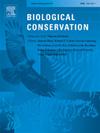Meadow orchards as a good practice example for improving biodiversity in intensive apple orchards
IF 4.9
1区 环境科学与生态学
Q1 BIODIVERSITY CONSERVATION
引用次数: 0
Abstract
Changes in agricultural land use and management are largely responsible for the current global biodiversity crisis. Addressing this crisis necessitates a change in management practices that are considered to limit biodiversity. Comparing intensive land-use forms with their extensive and traditional counterparts can help define good practice example for integrated conservation.
We compare remnants of traditional meadow orchards with intensively managed apple orchards in a mountain region by investigating the multi-taxonomic diversity of seven groups (including vascular plants, wild bees, diurnal butterflies, orthopterans, spiders, birds, and bats) and macro-invertebrates inhabiting four habitat strata (soil, ground-dwelling, herb, and tree layer). Each group and stratum was sampled with a target sampling method.
We found a consistent trend of higher abundance, diversity, and presence of threatened species in meadow orchards compared to apple orchards. Specifically, wild bees, butterflies, orthopterans, and birds showed significantly lower diversity in apple orchards across different diversity indices. Furthermore, multi-taxonomic indices of all taxa and most habitat strata followed the same trend, supporting the conclusion that these findings are applicable to the entire orchard ecosystem.
We conclude that traditional agroforestry systems, such as meadow orchards, could represent a well-suited good-practice example for integrated biodiversity conservation in the agricultural landscape. Finally, we emphasize the importance of maintaining traditional management practices through effective conservation measures such as subsidies as part of agri-environmental schemes.
草地果园是改善密集型苹果园生物多样性的良好实践范例
农业用地使用和管理的变化是造成当前全球生物多样性危机的主要原因。要解决这一危机,就必须改变被认为会限制生物多样性的管理方式。我们比较了山区传统草地果园和集约化管理的苹果园,调查了栖息在四个生境层(土壤层、地栖层、草本层和树木层)的七个类群(包括维管束植物、野生蜜蜂、昼行性蝴蝶、直翅目昆虫、蜘蛛、鸟类和蝙蝠)和大型无脊椎动物的多分类多样性。我们发现,与苹果园相比,草甸果园中受威胁物种的丰度、多样性和存在率均呈上升趋势。具体而言,在不同的多样性指数中,苹果园中野生蜜蜂、蝴蝶、直翅目昆虫和鸟类的多样性明显较低。我们的结论是,草甸果园等传统农林系统可以作为农业景观中生物多样性综合保护的一个很好的实践范例。最后,我们强调通过有效的保护措施(如作为农业环境计划一部分的补贴)来保持传统管理方法的重要性。
本文章由计算机程序翻译,如有差异,请以英文原文为准。
求助全文
约1分钟内获得全文
求助全文
来源期刊

Biological Conservation
环境科学-环境科学
CiteScore
10.20
自引率
3.40%
发文量
295
审稿时长
61 days
期刊介绍:
Biological Conservation is an international leading journal in the discipline of conservation biology. The journal publishes articles spanning a diverse range of fields that contribute to the biological, sociological, and economic dimensions of conservation and natural resource management. The primary aim of Biological Conservation is the publication of high-quality papers that advance the science and practice of conservation, or which demonstrate the application of conservation principles for natural resource management and policy. Therefore it will be of interest to a broad international readership.
 求助内容:
求助内容: 应助结果提醒方式:
应助结果提醒方式:


